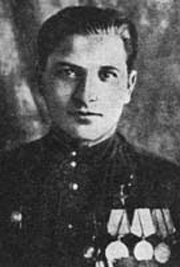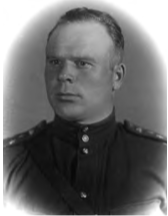
Mikhail Zakharovich Bondarenko was a navigator and squadron commander in the 198th Assault Aviation Regiment of the Soviet Air Forces during the Second World War who was twice awarded the title Hero of the Soviet Union for his ground-attack sorties on the Il-2 during the war.
Aleksandr Petrovich Yunev was a Red Army senior lieutenant and Hero of the Soviet Union.Yunev was awarded the title for his actions in Operation Spring Awakening for his part in repulsing numerous German attacks. Postwar, Yunev continued to serve in the army and died in 1952 as a result of his war wounds.
Ilya Timofeyevich Osipov was a Tatar Red Army soldier and posthumous Hero of the Soviet Union. Osipov was awarded the title for his work with pontoon bridges during the Battle of the Dnieper, but went missing in January 1944.

Fedir Trokhymovych Dyachenko was a Ukrainian soldier in the Red Army who became one of the top snipers in World War II. He was awarded the title Hero of the Soviet Union on 21 February 1944 for killing 425 enemy soldiers and officers.
Vasily Grigoryevich Kabanov was a Red Army major and Hero of the Soviet Union. Drafted into the Red Army in 1930, Kabanov fought in the Battle of Lake Khasan and the Battles of Khalkhin Gol as a tank company Politruk. After being seriously wounded in fighting around Leningrad, he took refresher courses at the Red Army Military Academy of Mechanization and Motorization. Kabanov returned to the front in January 1945 as a tank battalion commander and fought in the Vistula–Oder Offensive, where his battalion helped take Skierniewice. For his leadership, Kabanov was awarded the title Hero of the Soviet Union. He was mortally wounded during the Battle of Berlin.

Stepan Fyodorovich Shutov was a Red Army Colonel and double Hero of the Soviet Union. Shutov fought in the Russian Civil War and the Polish–Soviet War. He was demobilized after recovering from Typhus in 1921 but was drafted into the Red Army again in 1924. He initially served in cavalry units and later became an officer in the tank troops. When Germany invaded the Soviet Union, Shutov was a tank battalion commander. He fought in the Battle of Moscow. In December 1941, he became deputy commander of a tank brigade and in August 1942, was given command of the 187th Tank Brigade of the 9th Tank Corps. Shutov was appointed commander of the 50th Separate Guards Tank Regiment in October. From May 1943 he took commanders courses at the Military Academy of the Mechanization and Motorization of the Red Army. After graduation Shutov became commander of the 20th Guards Tank Brigade in August 1943. For his leadership of the brigade in the Battle of Kiev (1943), he was awarded the title Hero of the Soviet Union. During the Second Jassy–Kishinev Offensive the brigade captured Ploiești. For his leadership Shutov was awarded the title Hero of the Soviet Union a second time. In September 1944, he became 9th Guards Mechanized Corps deputy commander but a few days later was seriously wounded, resulting in the amputation of his arm while in the hospital. He retired in September 1945 and later became deputy minister for social welfare of the Belorussian SSR.

Avaz Hashim oglu Verdiyev was an Azerbaijani Red Army Senior Sergeant and a Hero of the Soviet Union. Verdiyev was awarded the title on 23 September 1944 for his actions during the Lvov–Sandomierz Offensive. During the offensive, he reportedly raised the red flag at the Staszów town hall during its capture. Verdiyev was seriously wounded in the Battle of Berlin and died of wounds on 1 May 1945.

Khydyr Hasan oglu Mustafayev was an Azerbaijani Soviet Army Colonel and a Hero of the Soviet Union. Mustafayev was awarded the title on 10 January 1944 for his leadership of a battalion in the capture of Fastiv. Mustafayev retired from the army in 1954 and worked in senior positions in the party and government.
Khalil Mammad oglu Mammadov was an Azerbaijani Militsiya Major general, Hero of the Soviet Union, and Minister of Internal Affairs of the Azerbaijan SSR. Mammadov fought in World War II, eventually becoming a tank battalion commander. He was awarded the title for his actions during the Second Jassy–Kishinev offensive, in which the battalion captured Roman. He retired from the Army postwar with the rank of Major. Mammadov worked in the Azerbaijan SSR Ministry of Internal Affairs and became a Militsiya Major general. Between 1960 and 1965 he served as Minister of Internal Affairs of the Azerbaijan.

Andrey Georgyevich Shebalkov was a Red Army senior sergeant and a Hero of the Soviet Union. Shebalkov was awarded the title on 24 March 1945 for his actions during the capture of Inowrocław during January 1945. He captured the commander of German troops in the city and with his squad killed numerous German soldiers. Shebalkov demobilized after the end of the war and was arrested on charges of writing anti-Soviet letters in 1948. He was stripped of his awards and imprisoned in the Gorlag at Norilsk. After Stalin's death Shebalkov was released and his awards were restored. He worked as a mechanic in Zelenokumsk.

Vasily Dmitrievich Myachin was a Soviet Army colonel and a Hero of the Soviet Union. Myachin was awarded the title Hero of the Soviet Union for his leadership of a battalion during the Berlin Offensive. Postwar, Myachin continued to serve in the army, retiring in 1978, after which he worked as an air traffic controller.

Iosif Iraklievich Gusakovsky was a Soviet military leader during World War II who was twice awarded the title Hero of the Soviet Union during World War II for his command of the 44th Guards Tank Brigade. He remained in the military after the war and in 1968 became the General of the Red Army.

Zakhar Karpovich Slyusarenko was a Soviet Ukrainian tank officer who rose from battalion commander to brigade commander during World War II and was twice awarded the title Hero of the Soviet Union.

Semyon Vasilyevich Khokhryakov was a T-34 tank battalion commander during World War II who was twice awarded the title Hero of the Soviet Union.

Leonid Sergeyevich Chigin was a Red Army colonel and a posthumous Hero of the Soviet Union.

Khamazan Gataullovich Gizatullin was the commander of a 45-mm gun of the 63rd separate anti-tank fighter battery of the Red Army during World War II and a recipient of the title Hero of the Soviet Union.
Aleksey Afanasyevich Pasko was a junior lieutenant of the Red Army. He fought in the Second World War, being awarded the title of Hero of the Soviet Union in 1945.
Samig Fayzullovich Abdullayev was an Uzbek soldier in the Red Army during World War II who was awarded the title Hero of the Soviet Union on 16 May 1944. After the war he became a painter and became an Honored Artist of the Uzbek SSR for his work. For ten years he was the head of the Union of Artists of the Uzbek SSR.
Rem Abzalovich Abzalov was a Red Army officer who was awarded the title Hero of the Soviet Union in 1945.
Stepan Vasilyevich Petrenko was one of the top Soviet snipers in World War II. He killed 422 enemy soldiers by mid September 1944 and was awarded the title Hero of the Soviet Union on 24 March 1945.












